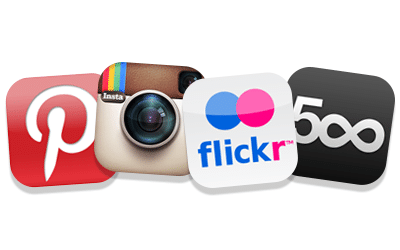How to Use Images for Online Marketing
Are you having a hard time writing more articles to market your business? Does the thought of trying to make a video make you scratch your head? There is another way to create great content to market your business online and it’s easier than you think.
In this article we are going to show you how to use images for online marketing to help you build brand awareness, grow your search traffic and increase your social following online.

Images for Online Marketing?
You may be asking yourself how in the world an image is going to be as effective as a well written article or a viral video in marketing your business. If so, you’re not alone. In our opinion, images are one of the most under-appreciated, and sometimes forgotten, types of content used for online marketing.
What’s funny is that most people are already familiar with a lot of different types of images that companies have used to market their business. This list of image types might help to remind you how widely used images actually are…
- Photographs
- Infographics
- Logos
- Icons
- Typographic images
- Charts
- Graphs
- Cartoons
- Illustrations / Drawings
Creating an Image Marketing Strategy
It’s never easy convincing someone that one of their top traffic sources can be an image based website like Google Images or Pinterest. However, we continue to see it happen as more businesses are getting creative, and aggressive, with their image marketing strategies.

To help you take advantage of these fantastic traffic referral sources we have outlined some essential steps to create your own effective image marketing strategy.
STEP 1: Optimize the Images on Your Website / Blog
Grab the low hanging fruit first by optimizing the images you have created on your website / blog. Properly optimized images can help your web properties to show up in image searches on Google, Yahoo and Bing. Not only can these channels drive good traffic, but they can sometimes be great sources for valuable backlinks as well.
Optimizing your images is easier than you think too. Just make sure the following HTML is in place on each photo: title (title=”What do I want people to see when they hover over this photo?”) and alt (alt=”What do I want search engines to know about this photo?”).
Example of Proper Image HTML:
<img src=”http://www.domain.com/images/example-image” title=”Explanation of Example Image” alt=”Example image” >
STEP 2: Setup Accounts on 1-2 Image Sites that You’ll Actually Use
With the exception of locking up your brand name on as many popular sites as possible, there is no point in overwhelming yourself with accounts on image sites that you’ll never use. Instead, research the different image sites and then choose 1 or 2 that fit your business well and attract users within your target audience.
Once you’ve selected these, then go ahead and setup your profile on each by completing these steps:
- Select your username
- Customize your profile photo
- Add an interesting company description
- Include your website address
- Connect your other social networks for easy sharing
- Invite your current friends / followers
STEP 3: Start with What You Already Have
Before you get trigger happy with your iPhone camera, kick off your image marketing by taking inventory of and using some of the images you already have. You’re going to have a much harder time gaining momentum with your new image sharing accounts if you just start with a blank slate. Instead, go through your website / blog and pull out images that you have created yourself and get some of those uploaded to your new profiles.
STEP 4: Know How to Work the System
Once you’ve selected the images you want to start with, and the image sharing sites you feel best fit your business, then the next step is get those images added. Before you just start throwing things online you need to make sure you understand the intricacies of the image sharing site(s) you select.
Let’s assume you’ve selected the two most popular sites (currently)…
Pinterest. With Pinterest, good organization is key. Before uploading your photos create a few boards (if you completed the TIP in STEP 3 above then you should be able to use the themes of the folders you setup) and give each board a good description. Next, start “pinning” images, preferably by using the links on the web pages they are currently on, and making sure to include a good, but short description for each image as well. Try to include popular hash tags where they are relevant to help people find your images easier.
Instagram. With Instagram, photo quality and hash tags are key. Great shots with the popular hash tags can attract a lot of “likes” quickly. Don’t overdo the hash tags though – keep them to 2-3 maximum or you’ll start to annoy other users. Since images are not organized into boards here, like Pinterest, hash tags are what make your images searchable for other users. Research what the most popular hash tags and use them wisely to get more followers and likes.
STEP 5: Mix it Up
No matter which image sharing sites you have selected it is always important to mix up the type of images you use. Unless you’re a professional photographer or artist with a very specific, expected style, then your audience is going to want to see some diversity with what you share. Now, this doesn’t mean that you should just start sharing and pinning anything and everything. You still to maintain some consistency, but using different image types can help to expand your reach and increase engagement.
Photographs are typically the most effective forms of image types used in marketing, but try working in some other variations as well. We have provided a full list above, but some of our favorite image types to mix in are:
- Infographics
- Charts / graphs
- Cartoons / illustrations
- Typographic images
STEP 6: Get Some Exposure
As with any type of content, even the best content pieces can fall short of your expectations if you don’t get them noticed. Fortunately, images, like videos, are typically much easier to promote than a more traditional article. On top of that, image sharing sites make it extremely easy to share your images to other people.
One of the easiest ways to get your images noticed is to use social media marketing. First, connect your image sharing sites to your Facebook and Twitter accounts to make sharing simple from within the applications. Next, make sure to cross-promote your image(s) across your different social networks to expand its reach. Then, reach out to influencers online and ask them to check out and share an image that would benefit their followers. And finally, find some niche sites to participate in and share your images on (e.g. 500px if you’re a professional photographer)
Let Your Images Speak for You
It’s never been easier to capture, create and use images to get your message out to those willing to listen. And if your business is one that creates amazing products and provides unforgettable experiences, then your audience wants to hear from you even more. Images, as we have shown, are a fantastic way to do just that.
With a solid strategy, a little creativity and a lot of commitment, images can be used very effectively to help businesses get more exposure and create more business.
Whether you’ve already jumped into image marketing and now just need some guidance or you’re still scratching your head as to how you can use images to grow your business, we want to help. Our team of designers and strategists have the creativity and experience you need to plan and implement an effective strategy.
All you have to do is click the big orange button below to schedule your FREE consultation and learn more.
Are you ready to talk about how images can be used to market YOUR business?